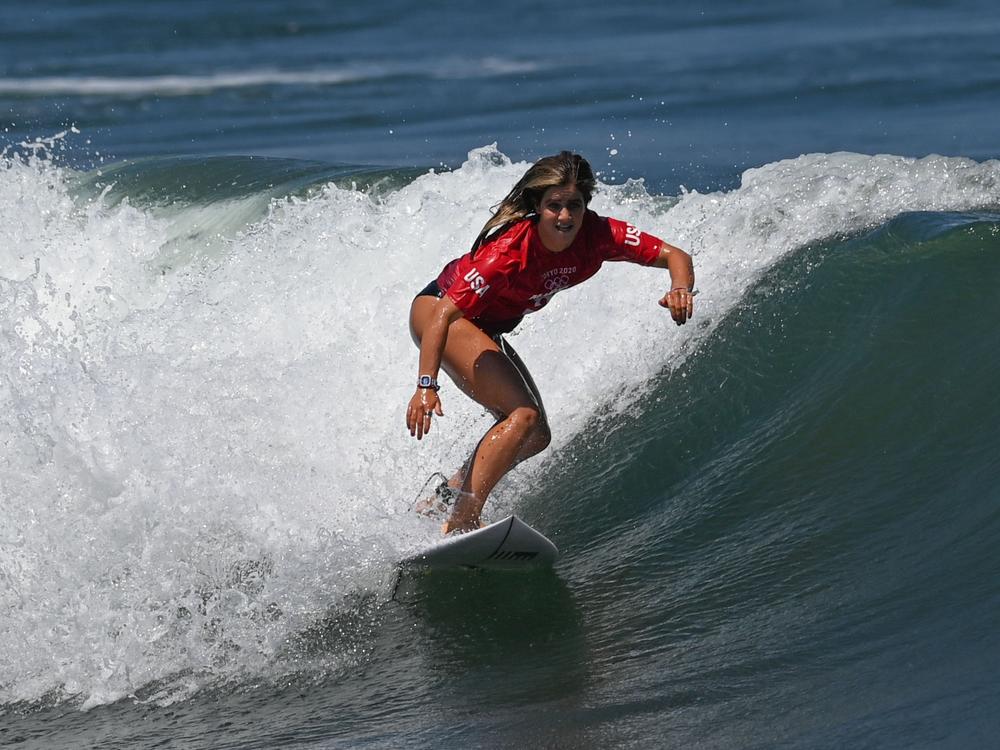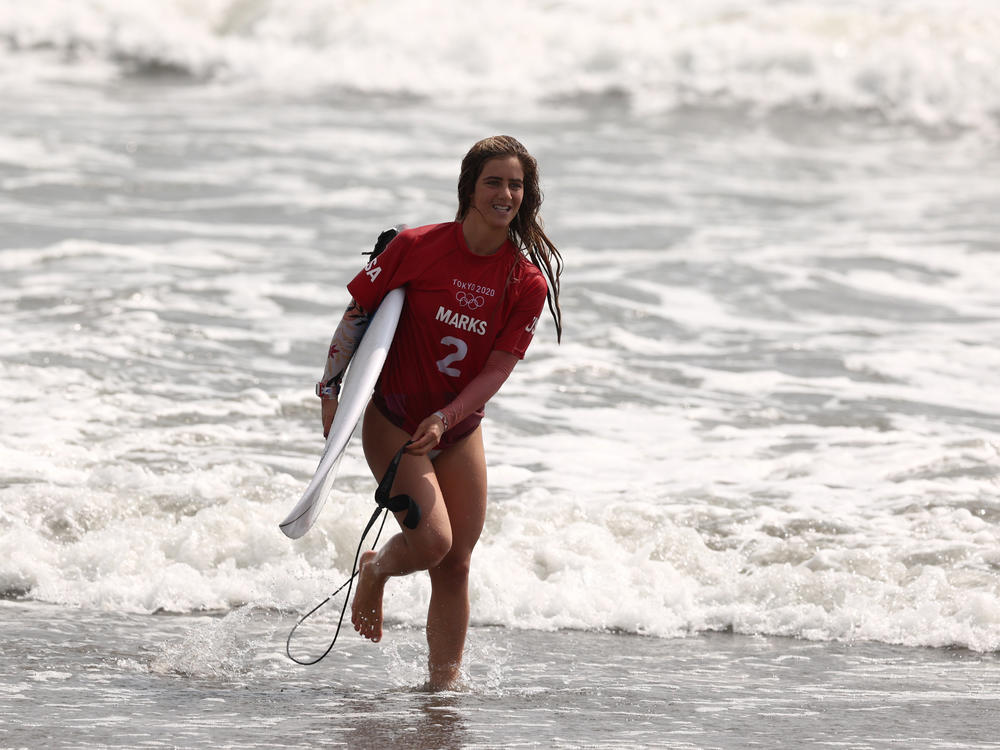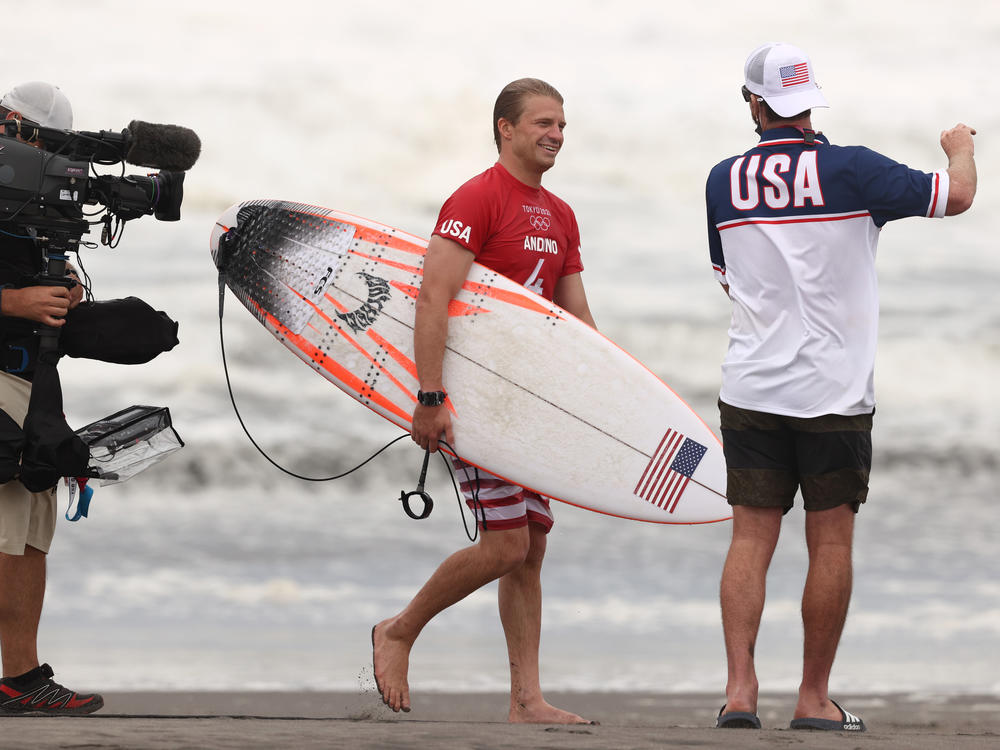Section Branding
Header Content
Surfing Makes Waves At The Olympics For The First Time
Primary Content
Surfing has deep roots, but for the first time, surfers are competing for medals at the Summer Olympics. At Tsurigasaki beach, 40 miles from Tokyo, they're also riding big waves ahead of a tropical storm.
"The incoming tide push over the afternoon does look to provide a lot of fun waves," reports Kurt Korte, the official surf forecaster for the Tokyo Olympics. He works for Surfline, a company based in Huntington Beach, Calif. He says while it might rain at Tsurigasaki beach, it should be a great day for the surfing finals at the Olympics.
While new to the Olympics, surfing has a long history
In pre-Inca Peru and wherever there's been a nearby ocean, people have been surfing in one form or another. Ancient warriors in Tahiti and Samoa used to train by surfing. In Polynesia, surfing was also considered an art form. But modern surfing... balancing on top of a board to ride waves for fun... became popular near the start of the 20th century in Hawaii.
Getting surfing to the Olympics was a dream of Hawaiian Duke Kahanamoku more than a century ago. Decades before Hawaii became a U.S. state, he earned five Olympic medals (three gold and two silver) for swimming, starting in 1912. Kahanamoku had grown up surfing with his brothers in Waikiki.
"Hi surfers, aloha," he says in old film footage. A CBS News reporter in the 1960's once asked him, "Duke, was it more of a thrill for you to win those Olympic Games, or ride some of those giant waves at Castle surf you used to ride?"
"I think surfing is much more to me, the greatest thrill of my life," he answered.
Tall, with broad shoulders and a big smile, Kohanamoku promoted surfing as he travelled the world. He even made a few Hollywood cameos...often playing Hawaiian chiefs, as he did in the 1948 film Wake of the Red Witch.
There's a statue of Duke Kohonamoku in Huntington Beach, Calif., also known as Surf City USA. It's one of the Southern California surf spots that made its way into pop culture in the 1950s and '60s.
Hollywood featured surfing in the Gidget movies in the 1950s. And the Beach Boys sang "Everybody's gone surfin', Surfin' USA."
Olympics and surfing's chill vibe may clash
During novelty exhibitions years ago, surfers on long boards would lift bikini-clad partners like pair figure skaters. And there were surfing contests, says former pro surfer Matt Warshaw, who curated an online Encyclopedia of Surfing.
"There's a lot of competition that goes on in the water, from wanting to be better than the surfer next to you or wanting to do better than you did the last time you surfed or just competition for waves, because the the resource is so limited," he says. "But it's a tricky one when it comes down to gathering people together and sending them out and trying to figure out who wins."
Warshaw, who used to write for and edit Surfer Magazine says formal competitions, especially the Olympics, don't exactly match surfing's endless summer, meditative, chill vibe.
"Instead of heading out there and finding a great wave, you have to surf when somebody else tells you, and the idea is to go out to beat the other guy or the other three guys," says Warshaw. "It's almost opposite of what most people surf for."
Unlike most other sports in competition at the Olympics, Warshaw says, so much of surfing depends on Mother Nature: the wind and the waves. "The ocean famously doesn't do what you expect it to do," he notes.
Surfing depends on Mother Nature
San Onofre Beach, north of San Diego, is one of the local breaks for 19-year-old Caroline Marks. She began surfing in Florida when she was three years old, sitting on the back of her dad's long board. Marks became the youngest woman to compete in a World Surf League event. Now, along with Carissa Moore from Hawaii, Marks is surfing at the Tokyo Olympics for Team USA.
"It's super surreal and incredible and pretty amazing. So I'm stoked," she said at a surf competition before leaving for Japan.
Marks is a "goofy-footed" surfer, meaning she uses her right foot in front of her surf board. With her low stance, she sprays the sky when she goes near the lip of a wave. She says the Olympics are opening surfing up to a bigger audience around the world. But she's trying to maintain her cool surfing vibe.
"I guess I'm just thinking about the next wave," she said. "It's so special to be in the ocean. It's like, you're just living in the moment, I guess. So it's pretty cool."
At the Olympics she'll have to live in the moment AND compete at the same time. "Yeah, for sure," she said. "I think when you think less it's almost better, at least for myself. You know, if I kind of just do it and just kind of go with the flow, that's when I do my best."
On the U.S. men's Olympic surfing team is John Florence, from Hawaii, and Kolohe Andino, from San Clemente, Calif.
"Honestly I want to compete like a savage beast," Andino said. "Relentless and yeah, ready to rip heads off."
Gnarly or chill, these surfers are hoping for some sick waves for the Olympic finals. But with the ocean, you never know.
Copyright 2021 NPR. To see more, visit https://www.npr.org.



